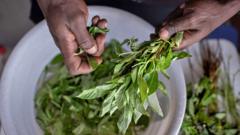Article:
Indigenous leafy vegetables, once scorned as mere weeds in Kenya, are now gaining popularity in the nation's culinary scene, marking a shift in dietary preferences. At the bustling Skinners Restaurant in Gachie, just outside Nairobi, the demand for "kienyeji" or local vegetable varieties has overtaken that for other greens, despite the higher prices associated with their production.
Restaurateur Kimani Ng'ang'a shares that customers are actively requesting these indigenous greens, suggesting a growing awareness of their nutritional advantages. Traditional staples like cabbage, kale, and spinach are now seen competing with nutrient-dense options such as "managu" (African nightshade) and "mrenda" (jute mallow), touted for their superior health benefits.
Professor Mary Abukutsa-Onyango, a horticulture expert, confirms a noteworthy doubling in local greens production over the last decade, with 300,000 tonnes cultivated last year. This revival illustrates a remarkable reversal in public perception, as these indigenous plants were historically undervalued for their resistance to pests and diseases—which makes them suitable for organic farming.
In the 1980s, Abukutsa-Onyango faced challenges in promoting these crops, which were often categorized as "weeds." However, her efforts have since garnered recognition from Unesco for their role in preserving Kenya's intangible cultural heritage related to food diversity and agricultural practices.
Despite traditional vegetables gaining traction, exotic varieties still dominate production, with over 700,000 tonnes of sukumawiki alone grown in 2023. Farmer Francis Ngiri recounts the journey of reintroducing native crops on his Rift Valley farm after witnessing the detrimental effects of chemical farming on local biodiversity.
Seed exchange has become a vital part of safeguarding indigenous crops, although current legislation complicates these efforts by limiting farmers' abilities to share uncertified seeds. Wambui Wakahiu from the Seed Savers Network emphasizes the need for reform to allow farmers to cultivate and exchange these vital crops freely, promoting biodiversity.
The cultural shift towards indigenous vegetables is bolstered further by media campaigns that highlight their health advantages. Vendor Priscilla Njeri notes that her customers prefer greens like managu and terere, thanks in part to the awareness generated by these campaigns.
As the culinary landscape in Kenya embraces its heritage, the resurgence of indigenous leafy vegetables not only enriches local diets but also points toward a future where traditional farming practices and biodiversity are celebrated.
Indigenous leafy vegetables, once scorned as mere weeds in Kenya, are now gaining popularity in the nation's culinary scene, marking a shift in dietary preferences. At the bustling Skinners Restaurant in Gachie, just outside Nairobi, the demand for "kienyeji" or local vegetable varieties has overtaken that for other greens, despite the higher prices associated with their production.
Restaurateur Kimani Ng'ang'a shares that customers are actively requesting these indigenous greens, suggesting a growing awareness of their nutritional advantages. Traditional staples like cabbage, kale, and spinach are now seen competing with nutrient-dense options such as "managu" (African nightshade) and "mrenda" (jute mallow), touted for their superior health benefits.
Professor Mary Abukutsa-Onyango, a horticulture expert, confirms a noteworthy doubling in local greens production over the last decade, with 300,000 tonnes cultivated last year. This revival illustrates a remarkable reversal in public perception, as these indigenous plants were historically undervalued for their resistance to pests and diseases—which makes them suitable for organic farming.
In the 1980s, Abukutsa-Onyango faced challenges in promoting these crops, which were often categorized as "weeds." However, her efforts have since garnered recognition from Unesco for their role in preserving Kenya's intangible cultural heritage related to food diversity and agricultural practices.
Despite traditional vegetables gaining traction, exotic varieties still dominate production, with over 700,000 tonnes of sukumawiki alone grown in 2023. Farmer Francis Ngiri recounts the journey of reintroducing native crops on his Rift Valley farm after witnessing the detrimental effects of chemical farming on local biodiversity.
Seed exchange has become a vital part of safeguarding indigenous crops, although current legislation complicates these efforts by limiting farmers' abilities to share uncertified seeds. Wambui Wakahiu from the Seed Savers Network emphasizes the need for reform to allow farmers to cultivate and exchange these vital crops freely, promoting biodiversity.
The cultural shift towards indigenous vegetables is bolstered further by media campaigns that highlight their health advantages. Vendor Priscilla Njeri notes that her customers prefer greens like managu and terere, thanks in part to the awareness generated by these campaigns.
As the culinary landscape in Kenya embraces its heritage, the resurgence of indigenous leafy vegetables not only enriches local diets but also points toward a future where traditional farming practices and biodiversity are celebrated.

















